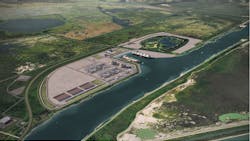Sempra Infrastructure moving forward to build Gulf Coast LNG project
Energy infrastructure developer Sempra Infrastructure Partners has reached a positive final investment decision to develop, construct and operate Phase 1 of the Port Arthur LNG project in Jefferson County, Texas.
The Port Arthur LNG Phase 1 project is designed to include two natural gas liquefaction trains, two LNG storage tanks, and related facilities, with a nameplate capacity of approximately 13 million metric tons per annum (Mtpa). Train 1 and Train 2 are expected to come into operation in 2027 and 2028, respectively.
The estimated capital expenditures for the Phase 1 project are $13 billion. Sempra says it has also finalized the project’s non-recourse debt financing amounting to $6.8 billion.
Sempra Infrastructure has engaged Bechtel Energy, a global engineering, construction and project management firm, for the implementation of the project. It has issued a final notice to proceed with the project.
Additionally, the company revealed the closing of its joint venture (JV) with an affiliate of oil and gas producer ConocoPhillips. Following the closing of the JV, the ConocoPhillips affiliate has acquired a 30 percent non-controlling interest in the project.
Under a 20-year sale and purchase agreement, the affiliate will also procure 5 Mtpa of LNG from the project and oversee the project's overall natural gas supply requirements. Furthermore, ConocoPhillips will also have certain rights to partake in future expansion projects in both equity and offtake.
New LNG projects strengthen U.S. position as World's Largest Exporter
Bechtel building LNG tanks in Taiwan
French-based Container Ships to be powered by LNG-fueled Wärtsilä engines
Read our latest newsletter for new stories on Rice Mill Microgrids and Rewiring New York
Late last year, Sempra announced an agreement to supply around 2.25 Mtpa of LNG to RWE Supply & Trading, a unit of German energy firm RWE, on a free-on-board basis for 15 years.
Many European countries are look for options to receiving natural gas from Russia since it’s invasion of Ukraine.
The deal also includes provisions for exploring ways to lower the carbon intensity of the LNG produced from the Port Arthur LNG Phase 1 project currently under development in Jefferson County, Texas. This may involve implementing greenhouse gas emission reduction strategies and a continuous improvement approach.
Sempra also announced that investment firm KKR has agreed to acquire an indirect, non-controlling interest of 25 percent to 49 percent in the Port Arthur LNG Phase 1 project. Under the deal with KKR, Sempra Infrastructure will retain certain economic and other rights related to the project while KKR will be granted certain minority interest protections. The investment will be made primarily by KKR’s Global Infrastructure Investors IV fund.
Sempra Infrastructure says it is targeting 20 percent to 30 percent of indirect ownership interest in the project, subject to the closing of the KKR sale.
The long-term contractable capacity of around 10.5 mtpa for the Port Arthur Phase 1 project has been completely subscribed under binding long-term agreements with Engie, INEOS, PKN Orlen, RWE Supply and Trading and ConocoPhillips, all of which became effective upon reaching final investment decision.
The Phase 1 project is expected to create an estimated 5,000 jobs during construction and boost the economies in Port Arthur and Jefferson County.
Sempra Infrastructure Partners is 70 percent owned by San Diego-based utility holding company Sempra, which also owns San Diego Gas & Electric and Southern California Gas.
The Gulf Coast LNG terminals take natural gas produced from U.S. wells and then utilize refrigeration trains to chill the natural gas to temperatures to minus 260 degree Fahrenheit (minus 162 Celsius). This converts the gas into a liquid, which is then exported to regasification units in other nations and then used for heating and power generation.
The dramatic rise in LNG export capacity was made possible by the shale gas drilling revolution combining hydraulic fracturing and directional drilling. U.S. production broke yet another record last year by topping 90 billion cubic feet per day, according to reports.
